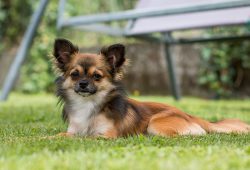The Chihuahua is the smallest breed of dog and is named after the state of [wiki title=”Chihuahua_(state)” base=”EN”]Chihuahua[/wiki] in [wiki base=”EN”]Mexico[/wiki]. Chihuahuas come in a wide variety of colors, and two coat lengths.
Description
There are two varieties of Chihuahua – the Smooth Coat (short haired) and the Long Coat. Both the Smooth and the Long Coats have their special attractions, are equally easy to keep clean and well groomed. The UK Kennel Club considers smooth and long coated Chihuahuas two distinct breeds, matings between the two are not eligible for KC registration.
Dogs of either coat type may be identified as either “apple head” or “deer head” Chihuahuas, particularly in the United States. Apple heads have rounded heads, close-set eyes, and relatively short ears and legs. Deer heads have flat-topped heads, more widely set eyes, larger ears, and longer, more slender legs. While deer heads were popular in the mid-twentieth century, current breed standards defined by registries such as the Chihuahua Club of America and American Kennel Club specify the apple head conformation.
Temperament
How a Chihuahua turns out depends mightily on the genetic temperament of his parents and grandparents. Chihuahuas can be easily provoked to attack, and are therefore generally unsuitable for homes with small children. The breed tends to be fiercely loyal to one particular person and in some cases may become over protective of the person, especially around other people or animals. They do not always get along with other breeds, and tend to have a “clannish” nature, often preferring the companionship of other Chihuahuas or Chihuahua mixes over other dogs. These traits generally make them unsuitable for households with children who are not patient and calm. If properly managed by older children, 13 and up, they can adapt to this kind of living with a dedicated owner. The temperament of its owner can make a difference in the temperament of the pup.
Chihuahuas love their dens and will often burrow themselves in pillows, clothes hampers, and blankets. They are often found under the covers or at the bottom of the bed, deep in the dark and safety of what they perceive as their den. Chihuahuas also enjoy time in sunlight.
Health
This breed requires expert veterinary attention in areas such as birthing and dental care. Dental care is a must for these small dogs, whose jaw size makes for weaker teeth.
Chihuahuas, and other toy breeds, can be affected by [wiki title=”Hydrocephalus” base=”EN”]hydrocephalus[/wiki]. Chihuahua puppies with hydrocephalus have an abnormally large head, are lethargic and do not grow at the same pace as their siblings. A true case of hydrocephalus can be diagnosed by a veterinarian, though the prognosis is grim.
Apple-headed chihuahuas can have [wiki title=”Molera” base=”EN”]moleras[/wiki], or a soft spot in their skulls, and they are the only breed of dog to be born with an incomplete skull. This is not a defect; it is a normal adaptation facilitating the passage through the birth canal and growth and development of the domed type of forehead. The molera is predominant in the apple heads and is present in nearly all Chihuahua puppies. The molera fills in with age, but great care needs to be taken during the first six months until the skull is fully formed. Some moleras do not close completely and require extra care to prevent injury.
Chihuahua (dog). (2017, July 25). In Wikipedia, The Free Encyclopedia. Retrieved from https://en.wikipedia.org/w/index.php?title=Chihuahua_(dog)&oldid=792208063


